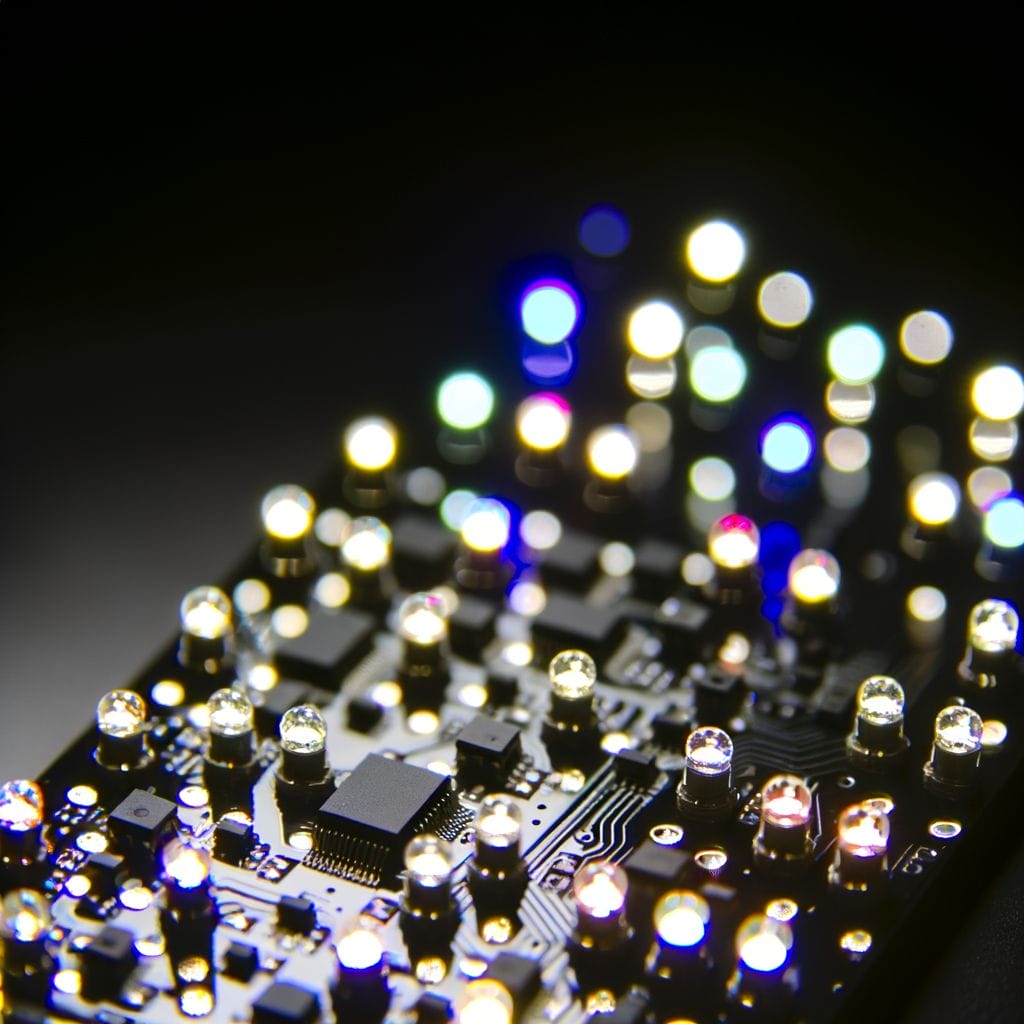Flashing LED Light Circuit: Master the Blinking Effect
Imagine a world where every single LED light blinks in perfect rhythm. Now, that’s a sight to behold! With a simple yet effective LED light circuit powered by a specified battery voltage, this mesmerizing visual can become a reality.
Today, we’ll explore the key components, learn how to construct one using transistors, and delve into alternative methods of creation. We’ll also touch on advanced topics to further enhance your knowledge. Intrigued? Let’s dive right in.
Key Takeaways
- Flashing LED light circuits are adjustable and can be used in various applications such as alarm systems, traffic lights, and advertising.
- They increase visibility and draw attention due to their blinking effect.
- Flashing LED light circuits are energy-efficient, environmentally-friendly, and have a long lifespan.
- The key components of a blinking LED circuit include transistors as switches, resistors and capacitors for delay effect, and a microcontroller for complex blinking patterns.
Introduction to Flashing LED Light Circuit and its Applications

Flashing LED light circuits, humble yet innovative, create a captivating blinking effect that’s both functional and adjustable. These circuits find applications in various sectors of our technologically-driven society. They draw attention in alarm systems, signal changes in traffic flow, and illuminate billboards in advertising, increasing visibility and catching the eye of potential customers.
One of the significant benefits of a flashing LED light circuit is its energy efficiency. LEDs consume significantly less power than traditional light sources, making them an environmentally-friendly choice. They also have a long lifespan, reducing the need for frequent replacements, making them an ideal indicator.
However, it’s worth noting that the frequency of the blinking effect, though adjustable, is often limited to a specific range. This limitation means that for applications requiring a highly specific frequency, a flashing LED light circuit may not be the ideal solution.
Key Components of a Blinking LED Circuit

Understanding the key components of a blinking LED circuit can turn this project into an exciting and rewarding endeavor. Transistors play a pivotal role, acting as switches that control the current flow. Resistors and capacitors work together to create the delay effect that we perceive as blinking. They regulate the current and store energy, respectively. Lastly, the microcontroller acts as the circuit’s brain, controlling how and when the LED blinks.
Mastering these components isn’t just about creating an LED that blinks; it’s about pushing the boundaries of what’s possible with simple electronic components.
Building Tutorial: Flashing LED Light Circuit Using Transistors

Now that we’ve covered the essential components of a blinking LED circuit, it’s time to guide you through the process of building your own flashing LED light circuit using transistors.
Transistors, the linchpin of our circuit, control the blinking effect. When used in conjunction with resistors and capacitors, they create an oscillating effect, causing the LED to flash.
- To build your flashing LED light circuit, start by arranging your components on the breadboard following the circuit diagram. Ensure that your transistors, resistors, capacitors, and LED are connected correctly.
- Once you’ve assembled your circuit, it’s time to power it up and witness the magic of the blinking effect. If done correctly, your LED should start to flash. Don’t be discouraged if it doesn’t work on the first attempt. Troubleshooting is part of the process when you are trying to build a blinking circuit, and offers you a chance to understand your circuit better.
- Remember, the goal here is to master the blinking effect. Don’t hesitate to experiment with different types of transistors or alter the values of the capacitors and resistors. This will change the rate at which your LED flashes, allowing you to customize your circuit according to your preferences.
Alternate Ways in Building Flashing LED Light Circuit

There are many ways to configure and build a blinking LED light circuit. The 555 Timer IC is a versatile device that can generate an adjustable square wave, which can be used to turn the LED on and off, creating the desired blinking effect.
Alternatively, a dual LED setup involves two LEDs that flash alternately. It’s a captivating way to add more dynamism to your project without requiring complex circuitry.
Lastly, an oscillator-based blinker uses an oscillator to control the LED’s blinking, often operating at a specific volt. It’s a bit more technical, but for those who relish a challenge, it’s an exciting way to create a customizable LED flasher.
How can I Incorporate LED Flickering Effects into a Circuit Design?
When incorporating LED flickering effects into a circuit design, it is important to consider the reasons for LED flickering. To achieve this, use a microcontroller to control the LED’s brightness and create different flickering patterns. Additionally, utilize PWM signals to control the LED’s intensity and create a realistic flickering effect.
Advanced Topics in Flashing LED Light Circuits

Let’s delve deeper into the world of flashing LED light circuits. This involves expanding our basic circuit to include multiple LEDs, utilizing the 555 Astable Circuit for timing control, and incorporating diodes for enhanced functionality.
Expanding our basic flashing LED light circuit to include multiple LEDs and various voltage thresholds isn’t as complex as it sounds. By connecting additional LEDs in parallel to the existing circuit, we can control multiple LEDs simultaneously, creating a more dynamic light display.
The 555 Astable Circuit is an excellent tool for controlling the blinking speed. By adjusting the intervals at which the capacitor discharges, we can control the speed at which our LEDs flash, allowing for a plethora of customization options.
Incorporating diodes into our circuit design enhances its functionality. Diodes protect our circuit from reverse currents and enable us to create different blinking patterns.
Here’s a quick reference table that summarizes our discussion:
| Topic | Description | Benefit |
|---|---|---|
| Multiple LEDs | Connect additional LEDs in parallel | More dynamic light display |
| 555 Astable Circuit | Controls blinking speed | Customizable blinking effect |
| Diodes | Protects from reverse current and creates blinking patterns | Enhanced circuit functionality |
Conclusion
We’ve delved into the world of flashing LED light circuits, from their applications to the key components involved. We’ve walked you through building one with transistors, and explored alternate methods too.
Hopefully, you’ve gained a good grasp on these circuits and are eager to explore more advanced topics. Remember, it’s all about understanding the basics first, then pushing boundaries.
So, keep experimenting, keep learning, and let your LEDs keep flashing!
Frequently Asked Questions
What is a flashing LED light circuit?
A flashing LED light circuit is a type of electronic circuit that uses components such as LEDs, resistors, capacitors, and integrated circuits to create a blinking or flashing effect in the LED lights.
How does a 555 timer relate to a flashing LED light circuit?
The 555 timer is a crucial component in a flashing LED light circuit. It is used to generate a square wave signal, which controls the blinking of the LED lights by toggling the output on and off.
What components are essential for building a flashing LED light circuit?
Building a flashing LED light circuit requires components such as LEDs, a 555 timer IC, capacitors, resistors, and a power supply. These components are used to create the blinking effect and control the flashing rate of the LEDs.
Can a microcontroller be used to create a blinking effect for LED lights?
Yes, a microcontroller can be programmed to control the blinking effect of LED lights, providing flexibility in adjusting the flashing rate, intensity, and patterns of the LEDs in the circuit.
What are some common ways to adjust the blinking rate and intensity of the LED lights in a flashing LED light circuit?
The blinking rate and intensity of the LED lights in a flashing LED light circuit can be adjusted by changing the values of the resistors and capacitors, or by using a microcontroller to dynamically control the blinking effect.







